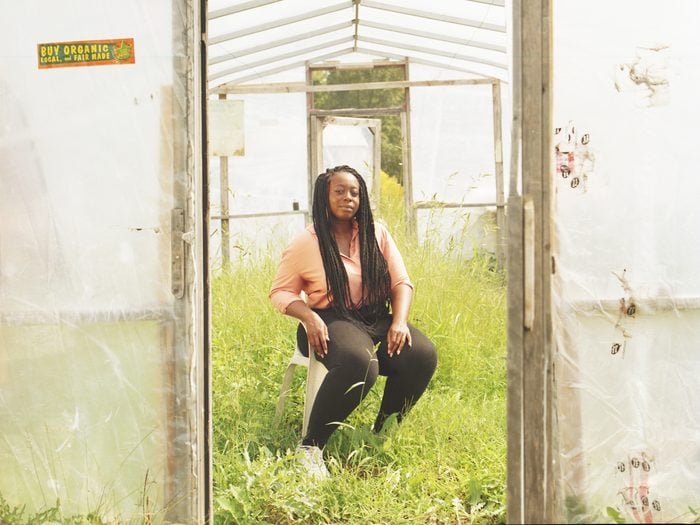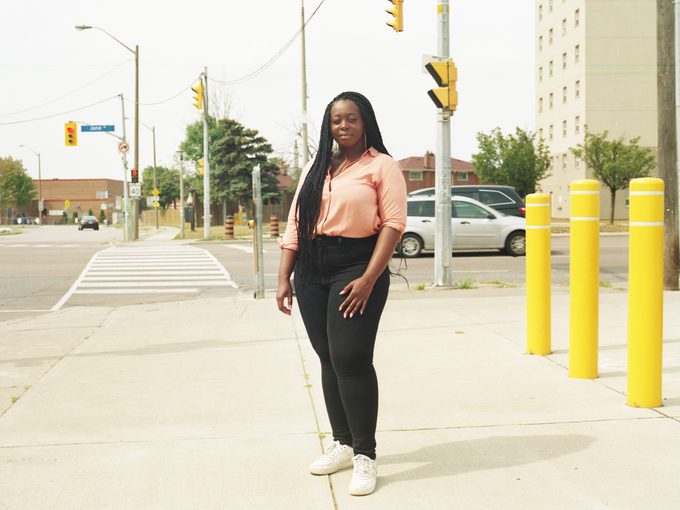Canada’s Dietitians Are Lacking in Diversity–But Things Are Changing

“Food insecurity is a huge issue in Canada, among Black and Indigenous communities in particular, and we often see those groups portrayed as having the worst health outcomes."
Rosie Mensah loved the richness and diversity of growing up in Toronto. She remembers days of playing at the park, meeting friends at the community centre, chatting with seniors she passed during walks and getting takeout from local Jamaican and Vietnamese restaurants. But throughout the vibrant community in her Jane and Finch neighbourhood, there were many food banks, several fast-food spots and neighbours in their 30s and 40s suffering with chronic illnesses, like diabetes and heart disease.
The produce at the local grocery stores was “quite poor,” recalls Mensah, and her family’s budget was tight. “I remember going to school and all the kids would only have $2 for lunch. I remember going to the mall and getting fast food because that was all we could afford,” she says, adding that healthier options were just not available.
Mensah describes her neighbourhood as a “food apartheid,” a term that reframes the concept of a “food desert” — a community where residents have limited access to affordable, healthy food options. Instead of grocery stores or farmers’ markets, these areas often have convenience stores, fast-food restaurants and gas stations. Referring to these neighbourhoods as food apartheids is intended to highlight the racist policies that systemically limit access to healthy food in racialized communities. Is healthy produce sold at an accessible price? Are the fruits and vegetables available appropriate for the cultural cuisines being prepared at home? Are locals able to grow their own food? In food apartheids, the answer to these questions is typically no.
Looking back, Mensah realizes her childhood experiences led to a flawed sense of what constitutes a “healthy” diet. The nutritional advice she learned in school and from health-care professionals wasn’t geared toward families or communities like hers—a glaring health gap in Canada that only recently started being addressed.
In Canada, diversity in dietetics is severely lacking. While there is a shortage of comprehensive data, Canada’s more than 10,000 registered dietitians are predominantly middle- and upper-class white women. In a 2020 survey, 96 percent of recent dietetic program graduates from across Canada identified as female and 79 percent identified as white, while only 12 percent identified as Chinese, three percent as South Asian and 1.7 percent as Métis. Dietitians of Canada only recently began collecting data regarding the diversity of its members but confirmed that at present, dietitians are not as diverse as the population they serve—a population in which one out of every five people identifies as a visible minority.
Mensah is Ghanaian Canadian, and growing up, she never encountered dietitians, doctors or nurses in her community who were people of colour. So she decided to become a health-care provider herself. “It made me feel like we always needed to see white people to fix us or make us better, because that’s all I saw. I wanted to become a health practitioner and serve people in my community,” she says.
Research shows that patients have better health outcomes when they interact with diverse health professionals and culturally specific approaches, such as receiving care in their preferred language or a diet plan tailored to their cuisine. Adapting dietary advice for diverse populations has been shown to help patients make healthier choices, reduce the risk of cardiovascular disease and help diabetes patients better manage their disease.
“As a dietitian, you have the opportunity to change lives through food and to increase health equity,” says Mensah, who is now a registered dietitian in Toronto. She has heard clients from the Caribbean, South Asia and parts of Africa describe traditional foods with shame because their cultural cuisine is not included in depictions of a nutritious diet. For example, white rice, a staple food in many cultures, is often branded as an unhealthy choice.
If someone doesn’t follow nutrition recommendations, dietitians will often label them as non-compliant, says Mensah, but that thinking glosses over important questions: Are the dietary recommendations aligned with their religious traditions? Do they live close to a grocery store?
“Food insecurity is a huge issue in Canada, among Black and Indigenous communities in particular, and we often see those groups portrayed as having the worst health outcomes,” says Mensah. “But we’re not doing the work to actually support them.”
(Related: Sharing Chinese Herbal Soups and Teas, Steeped in Tradition)

The farm increases access to healthy food through programming and food distribution projects. But what Mensah especially loves is how it empowers community members to change the food system themselves.
Supporting people to make healthy choices begins with expanding the idea of what healthy eating looks like. And the gaps in diet and nutritional care have not yet been addressed in official resources, such as Canada’s Food Guide. Long accepted as the definitive resource for what is “healthy,” Canada’s Food Guide has been criticized for designating dairy as an essential part of a healthy diet, despite high rates of lactose intolerance among many racialized groups. The 2019 revamp to the guide, the first in more than a decade, minimized dairy and meat recommendations and promoted a plant-heavy diet. The new guide promised to be more inclusive of multicultural diets, but nutrition experts say there’s still ample room for improvement.
Much of the government’s advice still ignores food access issues, such as geography and cost, says Mensah, and the recommended meals don’t necessarily represent the cuisine clients serve at home. “If so-called ethnic foods are mentioned, they are mentioned as foods to only eat sometimes, or as cheap eats or for entertaining purposes, instead of ways to nourish your body,” says Mensah. Dispelling misconceptions like this should be fundamental.
“As dietitians, it’s our job to learn about the foods our clients eat and encourage them to eat foods that are nutritious that represent them and represent their culture,” says Mensah.
—
Change starts with education, says Gurneet Kaur Dhami, who is completing her master of applied human nutrition at Halifax’s Mount Saint Vincent University. Dhami’s thesis research is on the experiences of racialized dietitians, and one barrier she highlights is the financial cost of entering the profession.
In its Equity, Diversity and Inclusion Audit and Strategy, released in March, the College of Dietitians of British Columbia flagged practicum requirements as a systemic barrier for students from Indigenous communities and low-income backgrounds. To become a dietitian, students must typically complete a minimum of 1,250 hours of practice-based learning for no pay.
But cost is only part of the picture. “Even when you have financial ability, if you’re going into a space and you don’t see yourself in the textbook or you see yourself in stereotyped roles, why would you want to be in that space?” says Dhami.
Mensah studied nutrition and dietetics at Western University’s Brescia University College and then completed a master of public health in nutrition and dietetics at the University of Toronto in 2018. In both schools, she was one of a few Black students. She is now one of the few Black dietitians in Canada.
During her education, she remembers a heavy emphasis on disease and nutritional interventions and little on oppression, anti-racism or how social determinants of health, like low income or housing instability, can impact someone’s diet. For example, Marley Fisher, an Indigenous dietitian from Munsee-Delaware Nation, says Indigenous people are often represented as unhealthy, with high rates of diabetes, drug use and obesity, with little explanation about the complex causes of these issues.
Fisher is a community dietitian at the Chippewa Health Centre in the Chippewas of the Thames First Nation in southwestern Ontario. The nearest grocery store is about a 30-minute drive, but many residents are living on a fixed income, and some do not have a driver’s licence or vehicle.
Nutrition and dietetics education programs rarely delve into these issues or the traditional food knowledge and cultural practices passed down through generations of Indigenous people, says Fisher. “Dietetics is an evidenced-based practice, and nutrition research based on traditional ways of knowing and doing is lacking in the field, as are Indigenous dietitians,” she says, noting she had only one teacher who was a person of colour in her undergraduate program at Brescia University College and at dietitian conferences, she rarely sees a speaker who is a person of colour.
“We can’t be colour-blind to the inequities and disparities, because that is a key part in doing our job in dietetics,” says Dhami, who had a similar experience in nutrition courses at the university formerly known as Ryerson. “Food is political, and we can’t treat it as being neutral.”
What is served for dinner reflects issues like access to financial resources, education and experiences of marginalization, explains Mensah. “All of that influences what you eat and, therefore, your access to food and your health outcome. That knowledge is so vital to our work, but it’s not part of our education.”
She explains that dietitians don’t need to know “everything about everyone’s culture,” but rather have a willingness to learn and ask questions.
Showing interest in learning a community’s language and culture is one way to build a strong relationship, says Fisher. “Providing culturally safe care can help combat the systemic racism usually felt by Indigenous people. Clients should feel comfortable telling their care provider about the cultural foods and dishes they eat, and dietary recommendations should be inclusive of these foods,” she says. Fisher adds that taking Indigenous cultural safety training, spending time in an Indigenous community, connecting with an Indigenous dietitian and reflecting on personal biases are all ways dietitians can better serve Indigenous clients.
(Related: “We’re Not Doing a Good Enough Job”: How Canada’s Health Gap Is Affecting Women)

Change in the field of dietetics is happening, particularly in the past year. Mensah believes seeing how racialized communities experienced worse outcomes from COVID-19 and the growing racial justice movement prompted more people to speak up about these issues within dietetics and placed more accountability on its institutions.
During consultations in 2020, Dietitians of Canada members made it clear that the profession needed to become more diverse and inclusive. As part of its 2020 to 2024 strategic plan, Dietitians of Canada committed to hiring a diversity, equity and inclusion consultant to help increase diversity and address systemic racism within the profession.
“Dietitians are really pushing to say that health can look different for everyone and that the foods you grew up eating can fit into a healthy style of eating. It’s not just a one-size white plate and a white kitchen with kale and lettuce,” says Barb Ledermann, a spokesperson for Dietitians of Canada.
When a client feels more comfortable with their health-care provider, they are more likely to keep appointments and listen to recommendations, says Mensah. She has seen this type of relationship lead to clients making changes that help them reach their goals, like being more physically active or cooking at home more often, as well as positive shifts in their mental health.
The Partnership for Dietetic Education and Practice, a group made up of the Alliance of Canadian Dietetic Regulatory Bodies, Dietitians of Canada and dietetic educators across Canada, defines the skills dietitians must upon graduation from one of Canada’s 16 dietetics programs or in-practicum programs. There’s now a requirement for all dietitians to “demonstrate an awareness of the ongoing impact of colonization, residential schools, intergenerational trauma and systemic racism on Indigenous peoples in Canada.” The new competencies require future dietitians to also recognize how their biases, beliefs, behaviours, power and privilege may affect others.
“Schools are going to have to teach their curricula according to these competencies. So we are at the beginning of a new era,” says Ledermann. She adds that Dietitians of Canada is working to increase diversity through recruitment and training dietitians to deliver culturally competent care.
Individual academic programs are also taking action. Last year, the University of British Columbia Dietetics program announced new steps to address systemic racism at the school, including integrating Indigenous perspectives and content throughout coursework and providing opportunities for students to complete Indigenous health-focused internships. At the university formerly known as Ryerson, online modules about anti-Black racism and oppression are being developed for graduate students and preceptors in the School of Nutrition.
Last year, Mensah created Culture, Equity, Diversity and Race in Dietetics, a self-paced online course for nutrition professionals that covers topics including terminology, cultural competency, health equity and food justice.
“I have seen shifts in people’s wellness and health when they feel seen and heard by their health professional,” she says. “[Making Canadian dietetics more inclusive] could impact people by making them feel more comfortable with their health professional—even following recommendations, coming back to appointments, being willing to actually share what’s going on—so they can receive the best care possible. It will be life-changing.”




